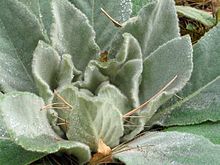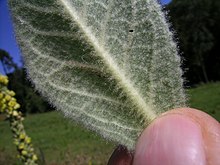Small-flowered mullein
| Small-flowered mullein | ||||||||||||
|---|---|---|---|---|---|---|---|---|---|---|---|---|

Small-flowered Mullein ( Verbascum thapsus ) |
||||||||||||
| Systematics | ||||||||||||
|
||||||||||||
| Scientific name | ||||||||||||
| Verbascum thapsus | ||||||||||||
| L. |
The small-flowered mullein ( Verbascum thapsus ) is a species of the fig family (Scrophulariaceae).
Common names
Other common names are small-flowered mullein, real mullein, lady candle, woman's candle, woolly flower, small-flowered woolly herb, sky fire, torch herb, weather candle, field candle, burning herb; in English: Flannelleaf, Flannelplant, Great Mullein.
description
Appearance
The small-flowered mullein grows as a biennial or perennial hapaxanthe , evergreen , herbaceous plant and reaches heights of 30 to 200 centimeters. A beet-like thickened main root and the thickened hypocotyl and epicotyl serve as storage organ . The stem axis is divided into a compressed, rosette-forming section and an elongated section that carries leaves. In the first year a rosette of large leaves is usually created, in the second year the long, richly leafed stalk is formed. Typical of the small-flowered mullein is the dense hair with grayish yellow star hair .
leaf
The basal leaves as well as the lower stem leaves are very short and indistinctly stalked. The leaf blade is oblong, lanceolate . The length is 15, the width 6 centimeters. The leaf margin is notched. The stem leaves are arranged alternately on the stem . Their size decreases continuously from the lower stem section upwards. Except for the lowest, the stem leaves are sessile. At their base, the stem leaves run down with their edges to the next lower stem leaf or beyond. This will wing the stem. The shape of the blades varies from oblong to oblong-ovoid. The top and bottom of the leaf form a thick, woolly, felted hair.
Inflorescence and flower
The flowers arise from the armpits ever smaller bracts and are close in ährig summarized arranged tangles. This elongated, cylindrical inflorescence reaches a length of about 30 centimeters, the width is about 2 centimeters. The flower stalks are relatively short.
The hermaphrodite flowers have a double perianth (perianth). The chalice has lanceolate lobes and a length of about 7 millimeters. The diameter of the corolla is 12 to 30 millimeters. The crown is wide funnel-shaped. The petals show a light yellow, rarely whitish color. The five existing stamens are divided into two longer and three shorter ones. The two longer stamens are bare, hairiness is seldom formed here in the lower stamen area. The shorter stamens have kidney-shaped anthers and white wooly hairs. The anthers of the longer stamens run down these briefly and are about 1.5 to 2 millimeters long. The length ratio of the dust bag to the filament is here 1: 3 to 1: 4. The upper ovary is undivided. The kidney-shaped scar does not run down the stylus . The flowering period extends from June to August.
fruit
An egg-shaped capsule fruit develops from the ovary . It is about as long as the permanent chalice. The fruiting season extends from July to October. The numerous, tiny seeds are spread over the wind. They are light germs .
Chromosome number
The number of chromosomes is 2n = 32 or 36.
ecology
Since the persistence organs are close to the earth's surface, the small-flowered mullein is counted among the hemicryptophytes . The small-flowered mullein is a half-rosette plant .
Flower biology
The hermaphroditic flowers are of the Verbascum type according to Kugler's flower biology . i.e., slightly bilateral symmetrical pollen disk flowers. The small-flowered mullein has no nectar , but offers its pollinators plenty of pollen . Typical pollinators are short- nosed bees , syrphids , beetles and flies . Within the flower, the female sexual organs - stylus and stigma - mature before the male reproductive organs, the anthers, although there is a longer temporal overlap of the male and female flower phases. This mechanism, botanically called weak proterogyny , easily promotes cross- pollination compared to self-pollination . This is supported by the fact that the insect flowers of spike-shaped inflorescences usually fly from the bottom up. As a rule, cross-pollination takes place; if this does not happen, spontaneous self-pollination takes place.
Synecology
The small-flowered mullein is an important fodder for some owl butterfly species. The gamma owl ( Autographa gamma ) is a polyphagous user of the small-flowered mullein. The lost mullein monk Shargacucullia thapsiphaga (considered lost in Germany) and the mullein monk Shargacucullia verbasci are oligophagous dependent on this species.
The small-flowered mullein can be attacked by the rust fungus Uromyces verbasci .
Occurrence
The small-flowered mullein occurs in almost all of Europe, in Macaronesia, Algeria, Morocco, West and Central Asia, in the Caucasus, in Siberia, China, India, Nepal, Bhutan and Pakistan. It is a neophyte in the Azores, Sri Lanka, Japan, Australia, New Zealand, Reunion, Hawaii, Canada, the United States, Argentina and Chile.
It grows on sunny, stony as well as moderately dry roadsides, in ruderal areas (gravel pits, gravel fields), wooded areas as well as on dams and banks. The plant is a nitrification indicator . In the Allgäu Alps, it rises in the Tyrolean part between Elbigenalp and Bernhardseck up to 1550 m above sea level. In Central Europe it is a characteristic species of the order Atropetalia.
Systematics
The type Verbascum thapsus was designed by Carl Linnaeus in 1753 Species Plantarum , p 177 first published . Synonyms for Verbascum thapsus L. are: Verbascum macrurum Lange , Verbascum simplex Hoffmanns. & Link .
Of Verbascum thapsus , there are about three subspecies :
- Verbascum thapsus L. subsp. thapsus , flowers 12 to 20 mm wide, occurring up to 1800 m height.
- Verbascum thapsus subsp. crassifolium (DC.) Murb. (Syn .: Verbascum crassifolium Lam. & DC. , Verbascum dubium Roem. & Schult. , Verbascum macranthum Hoffmanns. & Link ), crown 15 to 30 mm wide, more distinct stalked and less long descending basal leaves, densely hairy anterior stamens, up to Occurring altitudes of 2000 meters.
- Verbascum thapsus subsp. montanum (Schrad.) Bonnier & Layens : It occurs in Spain and the Balearic Islands.
Often it comes with Verbascum thapsus to the formation of hybrids with other Verbascum - species .
use
ingredients
Important ingredients of the small-flowered mullein are saponins , mucilage , flavonoids , sugar as well as yellow dyes and essential oils.
Phytotherapeutic use

A tea , tincture or syrup can be made from the leaves or flowers , which can be used for dry coughs , bronchitis or asthma , as the ingredients have an expectorant and expectorant effect. Furthermore, the healing of skin wounds is supported.
Use in tradition
The stems of the mullein species were previously dipped in resin or pitch and used as torches . The plant was also used for coloring.
According to old, pre-Christian and later Christianized customs, the mullein is in many places in Catholic areas part of the so-called spice tuft .
Popular belief
Popular belief is that with the help of woolly flowers a weather forecast for the coming winter is possible: loosely populated inflorescences should indicate periods with little snow, small inflorescences indicate winters with little snow, particularly long inflorescences with dense blooms indicate long, snowy winters.
literature
- Schmeil-Fitschen: Flora of Germany and its adjacent areas. Heidelberg 1973, ISBN 3-494-00327-0 .
Individual evidence
- ↑ See also Georg August Pritzel , Carl Jessen : The German folk names of plants. New contribution to the German linguistic treasure. Philipp Cohen, Hanover 1882; Reprint in 2 volumes, Amsterdam 1967, pp. 428–439.
- ↑ a b c Deyuan Hong, Hanbi Yang, Cun-li Jin, Manfred A. Fischer, Noel H. Holmgren, Robert R. Mill: Scrophulariaceae. ( Verbascum thapsus. P. 5 - same text as printed work) In: Wu Zheng-yi, Peter H. Raven (ed.): Flora of China . Volume 18: Scrophulariaceae through Gesneriaceae . Science Press / Missouri Botanical Garden Press, Beijing / St. Louis 1998, ISBN 0-915279-55-X (English).
- ^ A b c Wolfgang Adler, Karl Oswald, Raimund Fischer: Excursion flora from Austria . Ed .: Manfred A. Fischer. Eugen Ulmer, Stuttgart / Vienna 1994, ISBN 3-8001-3461-6 , p. 715 .
- ↑ a b Binz, Becherer, Heitz: school and Exkursionsflora of Switzerland , Schwabe & CO Verlag, Basel 1980, 17th Edition, ISBN 3-7965-0761-1 , S. 323
- ↑ a b Rothmaler: Excursion flora from Germany . 18th edition. Spektrum Akademischer Verlag, Heidelberg / Berlin 2002, ISBN 3-8274-1359-1 , p. 395.
- ↑ a b Ruprecht Düll , Herfried Kutzelnigg : Pocket dictionary of plants in Germany. A botanical-ecological excursion companion to the most important species. 6th, completely revised edition. Quelle & Meyer, Wiebelsheim 2005, ISBN 3-494-01397-7 , p. 501.
- ↑ a b Erich Oberdorfer : Plant-sociological excursion flora for Germany and neighboring areas . With the collaboration of Angelika Schwabe and Theo Müller. 8th, heavily revised and expanded edition. Eugen Ulmer, Stuttgart (Hohenheim) 2001, ISBN 3-8001-3131-5 , pp. 828 .
- ↑ a b Small-flowered Mullein . In: BiolFlor, the database of biological-ecological characteristics of the flora of Germany.
- ↑ Verbascum thapsus L., Small-flowered Mullein. In: FloraWeb.de.
- ↑ Small-flowered mullein as a fodder plant for the lost mullein monk at Lepiforum .
- ↑ Peter Zwetko: The rust mushrooms Austria. Supplement and host-parasite directory to the 2nd edition of the Catalogus Florae Austriae, III. Part, Book 1, Uredinales. (PDF; 1.8 MB).
- ^ A b Verbascum in the Germplasm Resources Information Network (GRIN), USDA , ARS , National Genetic Resources Program. National Germplasm Resources Laboratory, Beltsville, Maryland. Retrieved December 22, 2017.
- ↑ Seidel, Eisenreich: BVL identification book, photo plant guide . 2nd Edition. BVL Verlagsgesellschaft, 1985, ISBN 3-405-13087-5 , p. 26
- ↑ Erhard Dörr, Wolfgang Lippert : Flora of the Allgäu and its surroundings. Volume 2, IHW, Eching 2004, ISBN 3-930167-61-1 , p. 429.
- ^ Reprint of the original document for the first description by Linné , via the Biodiversity Heritage Library.
- ^ A b c d e Karol Marhold: Globulariaceae , 2011. Scrophulariaceae. : Datasheet Verbascum thapsus In: Euro + Med Plantbase - the information resource for Euro-Mediterranean plant diversity.
- ↑ a b Cooperation phytopharmaceuticals: Mullein in the medicinal plant lexicon (refers to large Mullein, the use of the small-flowered Mullein was permitted analogously)
- ↑ a b medicinal plants compilation at awl.ch .
- ↑ Portrait of the Mullein . ( Memento of March 4, 2011 in the Internet Archive ) BR-online
- ^ Edited by Oskar Sebald : Signposts through nature. Wild plants of Central Europe. ADAC Verlag, Munich 1989, ISBN 3-87003-352-5 , p. 260.
- ↑ State Association for Bird Protection in Bavaria : Botanical diversity in customs - Würzbüschel to the Assumption of Mary as a mirror of biodiversity. August 12, 2016 ( lbv.de , accessed August 31, 2019).
- ↑ Small-flowered mullein ( page no longer available , search in web archives ) Info: The link was automatically marked as defective. Please check the link according to the instructions and then remove this notice. at Vogelsbergportal.
Web links
- Profile and distribution map for Bavaria . In: Botanical Information Hub of Bavaria .
- Distribution in the northern hemisphere according to Eric Hultén
- Small-flowered mullein . Bavarian State Office for Environmental Protection
- Large-flowered mullein . Nature lexicon; with references to the small-flowered mullein
- Short compilation u. a. on the customs and legends of the mullein at ORF-Alpha: Women's days of the year.
- Flowers in Swabia Identification aids for small-flowered mullein .




